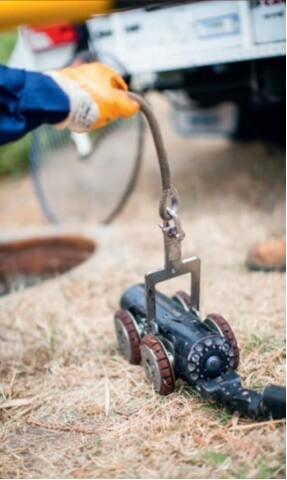Water authorities and underground pipeline operators have long struggled with the challenge of maintaining assets beneath the ground. Pipelines and storm water and sewer drains, in particular, are vulnerable to unseen damage, corrosion and blockages from tree roots that are seeking water. The results are deterioration, pipe wall loss and shifting pipes, which lead to severe cracking and blockages that gradually extend throughout the network.
Traditionally, these problems have been treated reactively with a degree of guesswork. Where a blockage is identified the action taken was to clear it and hope that the problem goes away. This may involve using methods such as machine rodding cutting to remove tree roots that would halt the immediate problem but without understanding the damage already caused. (A discussion of problem detection and pipeline condition assessment can be found in the article Corrosion Costs & Recommended Practices for the Water Industry.)
New Inspection Technology: Closed Circuit Television (CCTV)
Cameras have proven a significant advancement for the plumbing and building industry to be able to inspect pipes and identify causes of blockages, to pinpoint corrosion problems and prioritize maintenance works. As with all technology, cameras and associated equipment are continually evolving. We have moved from VHS to CD, to digital storage; and with these advancements, the quality and detail of the images captured are evolving as well.
With current camera technology, operators can easily identify damage and its cause, meaning they can accurately decide which method of cleaning or repairing will be most effective – high-pressure water jetting, rodding, or sewer machine cables for instance. In the past, a wrong decision could be costly. For instance high pressure water would be effective in clearing a blockage, but if concrete piping is in the early stages of corrosion, this process may blast away the surface, dramatically reducing the life span of the drain. For this reason the use of camera technology has become a critical tool in inspection, corrosion detection and assessment.

Figure 1. Closed circuit television (CCTV) camera in the field.
Camera technology has improved and embraced the latest advancements, including integrated camera, lights and software units that deliver detailed panoramic 360° views from inside a pipe. Where traditional push-rod camera systems act as a video recording system allowing the operator to only see the drain or pipe in one direction as they travel through it, these latest advancements capture images from inside the asset in both forward and away directions, weaving them into a ‘flat’ picture giving a true 3D image of the pipes interior.
The immense level of detail captured with the dual lenses, optimal lighting at the point of capture, and the ability to see all sides of an object through the woven image, gives the operator a new level of information to make informed decisions about the health of a pipe. It is possible to identify hairline cracking and other early indicators so that quick remedial action can be scheduled to prevent costly rectification works in the future.
The effect is achieved by two fisheye lenses, which take high resolution photos every 5 cm in both the forwards and backwards direction. The images are transmitted to the operator console and stitched together by the software to create a true 3D internal view of the pipe. (Read Using 3D Laser Analysis for Nondestructive Testing and Evaluation of Pipeline Corrosion for another method to capture 3D images.) This method eliminates the blurring that can occur with traditional cameras, as well as overcoming the limitations of single direction camera angles. It is very similar to using Google street view inside a drain.
Inspecting Pipeline Interiors
A further benefit of these new devices is their ability to cover hundreds of meters of straight pipe. Push-rod cameras are limited to the amount of bends or drops in the piping, whereas this new device is controlled by the computer system, either on four wheels or mounted on a flotation device. With features to zoom and pan 360° operators can look into inlets such as housing connection branches and closely examine objects such as displaced field joints and protruding pipe connections. With an option to allow vertical surveying of manholes with a separate camera these new cameras have a clear mobility advantage over traditional CCTV systems.
Conclusion
For water authorities and councils, who are under constant pressure to reduce operating expenses, drain surveillance technology is enabling a shift of focus from costly rectification works on demand to a predictable model using routine inspection and scheduled preventative maintenance. With each advancement in camera technology and improved imagery there are fewer pipes and drains that can’t be thoroughly examined, saving water authorities, councils, businesses and households the cost and disruption of unexpected blockages and deterioration of water infrastructure.